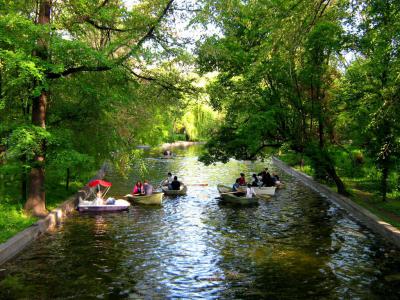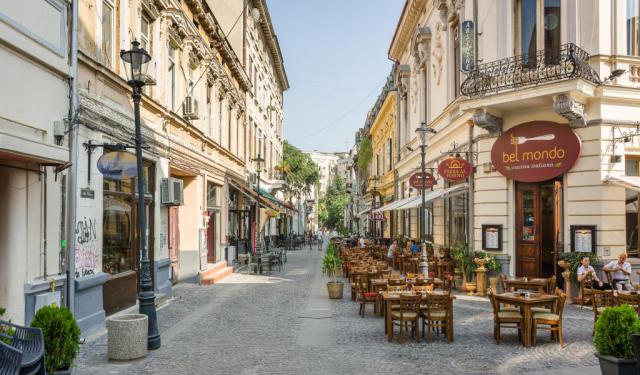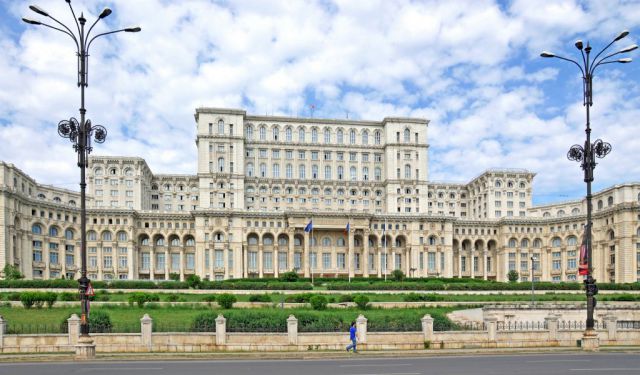
Cișmigiu Gardens, Bucharest (must see)
Cişmigiu Gardens is a public park dating back to the times when Bucharest was still the capital of Wallachia Principality. Established in 1847, this is the oldest and largest (17 hectares) green space in the city.
The park was laid out on a site formerly known as "Lake of Dura the Merchant", or simply Dura, a popular fishing ground from as early as the 17th century. Part of the present-day gardens was occupied by vineyard, planted around a water source.
The decision to replace the lake was taken in 1846, during a period of Imperial Russian administration, and was based on an earlier proposal made by Russian governor, Pavel Kiselyov, in 1830. The actual plan for the park was formulated in 1844, prior to which, in 1843, Prince Gheorghe Bibescu had called on experts in horticulture and landscaping to partake in restructuring the Dura area. Subsequently, the German horticulturist Wilhelm Friedrich Carl Meyer and his assistant, gardener Franz Hörer, answered the call and arrived in Bucharest.
Under their supervision, by 1851, new species of trees had been brought in including chestnuts from Gorj County, walnuts from Dâmboviţa County, and other plants from places like Vienna and Braşov. At the same time, the lanes were reinforced with debris from the ruins of Curtea Nouă and Zlătari area.
The word “cişmigiu” is of Turkish origin and translates as a person responsible for building and maintaining public fountains. The name replaced older references to Dura, and was coined by the public since, at that time, the administrator of Bucharest fountains was living on the park grounds.
Cişmigiu continued to be developed by Meyer long after its official inauguration. In 1870, he laid out a plan to redesign the lanes, introduce an artesian aquifer, and create a kiosk for an orchestra. He also proposed to have gondolas carrying visitors over the lake.
The park was laid out on a site formerly known as "Lake of Dura the Merchant", or simply Dura, a popular fishing ground from as early as the 17th century. Part of the present-day gardens was occupied by vineyard, planted around a water source.
The decision to replace the lake was taken in 1846, during a period of Imperial Russian administration, and was based on an earlier proposal made by Russian governor, Pavel Kiselyov, in 1830. The actual plan for the park was formulated in 1844, prior to which, in 1843, Prince Gheorghe Bibescu had called on experts in horticulture and landscaping to partake in restructuring the Dura area. Subsequently, the German horticulturist Wilhelm Friedrich Carl Meyer and his assistant, gardener Franz Hörer, answered the call and arrived in Bucharest.
Under their supervision, by 1851, new species of trees had been brought in including chestnuts from Gorj County, walnuts from Dâmboviţa County, and other plants from places like Vienna and Braşov. At the same time, the lanes were reinforced with debris from the ruins of Curtea Nouă and Zlătari area.
The word “cişmigiu” is of Turkish origin and translates as a person responsible for building and maintaining public fountains. The name replaced older references to Dura, and was coined by the public since, at that time, the administrator of Bucharest fountains was living on the park grounds.
Cişmigiu continued to be developed by Meyer long after its official inauguration. In 1870, he laid out a plan to redesign the lanes, introduce an artesian aquifer, and create a kiosk for an orchestra. He also proposed to have gondolas carrying visitors over the lake.
Sight description based on Wikipedia.
Want to visit this sight? Check out these Self-Guided Walking Tours in Bucharest. Alternatively, you can download the mobile app "GPSmyCity: Walks in 1K+ Cities" from Apple App Store or Google Play Store. The app turns your mobile device to a personal tour guide and it works offline, so no data plan is needed when traveling abroad.
Cișmigiu Gardens on Map
Sight Name: Cișmigiu Gardens
Sight Location: Bucharest, Romania (See walking tours in Bucharest)
Sight Type: Attraction/Landmark
Guide(s) Containing This Sight:
Sight Location: Bucharest, Romania (See walking tours in Bucharest)
Sight Type: Attraction/Landmark
Guide(s) Containing This Sight:
Walking Tours in Bucharest, Romania
Create Your Own Walk in Bucharest
Creating your own self-guided walk in Bucharest is easy and fun. Choose the city attractions that you want to see and a walk route map will be created just for you. You can even set your hotel as the start point of the walk.
Old Town Walking Tour
The Historical Center of Bucharest, or the Old Town, as the locals habitually refer to it, is one of the most beloved and attractive areas in the Romanian capital. The neighborhood is really beautiful a place to visit, and you can walk into it pretty much from anywhere in central Bucharest. Ion Constantin Brătianu Boulevard crosses the historic heart of the city from Piata Universitate... view more
Tour Duration: 2 Hour(s)
Travel Distance: 1.9 Km or 1.2 Miles
Tour Duration: 2 Hour(s)
Travel Distance: 1.9 Km or 1.2 Miles
Bucharest Introduction Walking Tour
Bucharest, the capital and cultural center of Romania, is one of the largest cities in Southeastern Europe.
The name București has an unverified origin. Tradition links it to the guy named Bucur, who (according to various legends) was either a prince, outlaw, fisherman, shepherd or a hunter. The Romanian word “bucurie” means joy (happiness), which in turn explains one of Bucharest's... view more
Tour Duration: 2 Hour(s)
Travel Distance: 3.7 Km or 2.3 Miles
The name București has an unverified origin. Tradition links it to the guy named Bucur, who (according to various legends) was either a prince, outlaw, fisherman, shepherd or a hunter. The Romanian word “bucurie” means joy (happiness), which in turn explains one of Bucharest's... view more
Tour Duration: 2 Hour(s)
Travel Distance: 3.7 Km or 2.3 Miles
Useful Travel Guides for Planning Your Trip
16 Uniquely Romanian Things To Buy in Bucharest
Nicknamed "Little Paris", today's Bucharest is the capital of a vibrant European nation, known as Romania, with lots of history and great cultural heritage - spanning from centuries-old rural traditions to New Wave cinema. Keen on rustic stuff, Romanians carefully preserve their...



